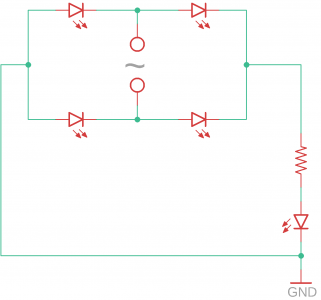Full bridge rectifier (full-wave bridge rectifier, diode bridge or sometimes just simply referred to as bridge rectifier) is something that everyone learning electronics is familiar with and the operating principle is also well understood. But if we could clearly demonstrate how it works in action, it would be even more beneficial.
To demonstrate how a bridge rectifier works, I used four LEDs instead of four diodes to form the diode bridge so that one can easily tell which diodes are conducting and which ones are not. In practice however, LEDs are rarely used as rectifying diodes due to their high forward voltage drop, low current carrying capability and low reverse breakdown voltage.
Another LED is used as the load so that you can clearly see the effect of the rectified waveform.
Because mains frequency is too high for human eyes to discern, I used a signal generator to generate the input waveform at a much lower frequency (e.g. 1 Hz) so that the results can be observed easily. The following short video illustrates and visualizes how a full bridge rectifier works with different input waveforms (sinusoidal and square wave), with and without a smoothing capacitor.


